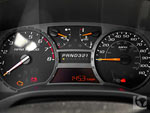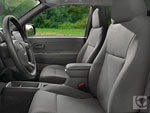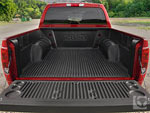 There are only two certainties in life: death and taxes. Unless you're Isuzu, in which case there's taxes. We're talking about a car company that hasn't sold a car since 1993, gave up their one American assembly plant in 2002, then finished off their two remaining products in 2004. Yet they survive.
There are only two certainties in life: death and taxes. Unless you're Isuzu, in which case there's taxes. We're talking about a car company that hasn't sold a car since 1993, gave up their one American assembly plant in 2002, then finished off their two remaining products in 2004. Yet they survive.Survive on what? On the generosity (and possibly excess production capacity) of former partner GM, that's what. The lone model on sale at Isuzu dealerships last year, the Ascender, ascended from the Chevrolet TrailBlazer SUV. This year, GM has chosen to donate the midsize pickups we know as the Chevrolet Colorado and GMC Canyon, thus continuing the long legacy of shared pickups between the two companies (Remember the Isuzu Hombre? Chevy Luv?). On some levels, at least, this seems like a mutually beneficial arrangement: GM gets to make use of the union labor they're paying for anyway, and Isuzu gets to enjoy a model roster 200% as voluminous as the year prior.
There's a lesson here: when you run out of life, borrow someone else's.
Road Test

Maybe we should be amazed that GM renewed its trucks' lease on life at all. Because smaller pickups comprise a segment not exactly brimming with prestige, sales, or attention, the previous Chevy S-10 and GMC Sonoma were left to flounder as-is since 1994 or 1982, depending on where you start counting. So a decade or two worth of change brings some plausibility to seemingly outlandish claims like a body that's 250% stiffer (!) than the last. Indeed, a drive over any surface reveals contemporary, vastly improved solidity from a rattle-free ride.
Not all claims carry as much foundation. Try this one on: GM believes this truck's Intelligent Start feature (prevents cranking of the ignition when the engine's on) is necessary because "the engines operate so quietly." Stated politely, I don't think that will be much of a problem. Firing up the i-350's five cylinders produces a tremble and a hoary growl that never quite goes away, and in case you forget, the engine's inherent lack of balance turns the steering wheel to a vibra-matic at every stoplight thereafter. This is all kind of hard to miss unless you're missing three of your physical senses.
Did I say five cylinders? I did, and they easily explain such symptoms. The explanation I'm looking for is why GM resorted to such an obvious measure of cheapness: essentially using the Chevy TrailBlazer's 4.2-liter Vortec engine with the sixth chamber cut off, plunging horsepower from 291 to 220, torque from 277 to 225, and sound quality by a similar amount if such a thing could be quantified. First impressions deserve first discussion.
Luckily, things improve from there. First, this engine doesn't sound quite as crummy as it does in a Hummer H3, probably because the 900-pound lightening relieved much of the strain. The engine certainly fulfills its tech quota, having aluminum casing, variable valve timing (only on the exhaust side, oddly), two overhead cams managing 20 valves, and 10:1 compression - all in all, a quantum leap over the Chevy S-10's old 12-valve all-iron pushrod 4.3-liter V6 with just 180 horsepower.
Considering the truck tuning, 220 is a decent HP number for a 3.5-liter (most competitors use 4.0s), and don't count me among the crowd who calls this truck underpowered, at least when driving solo and sans cargo. Yes, the i-350 is stuck with the slowest acceleration among all upper-level models (0-60 in 8.7 seconds while the V6 Japanese competition pulls low-7s), and its towing capacity - one of the few reasons to even consider a truck - tops out at a modest 4,000 pounds instead of the 6,500 of Tacomas and Frontiers and the 7,150 of V8-powered Dakotas. But a shove of the pedal still results in a shove of the back, and there is a slight payoff in fuel economy: an observed 19 MPG vs. 18 in a Tacoma and Ridgeline. Throttle response is nice and gradual, too.
The markedly stiffer chassis literally provides a backbone for a better ride, and as usual, GM tuned the suspension for further everyday friendliness. Indeed, the i-350 copes with individual bumps just fine. However, spending enough time on run-down freeways tests the resolve of the suspension, which with an unloaded cargo bed often shimmies and jumps with discomforting frequency; it can wear you out quite quickly. This at least applies to 4-wheel-drive models, where the live rear axle gets paired to cheap front torsion bars (good for off-roading, bad for on-roading) instead of the coil springs used by everyone else. Meanwhile, moderate noise penetrates the cabin, especially from wind.
Was any part of this truck spared by the not-so-invisible hand of cost-cutting? Don't look to the transmission - you'll only find four gears where everyone else gives five. It knows its stuff when it comes to shifting - probably why GM uses it on nearly every truck and SUV possible - but kickdowns are full of drama (and are common, given the just-adequate power) and the number four is looking more laggardly every year.
Don't look to the brakes, either: working on the back end is a cheap pair of drums (a step down from the S-10's 4-wheel-discs). Here, the disconcertingly mushy brake feel gets compounded by marked body dive - the dark side of that soft suspension. Stopping distances aren't confidence-inspiring in the least, with the best recorded distance from 60 MPH being 140 feet. And you are responsible for all braking, since there's no stability control to save you in any situation - a glaring safety omission in what is a relatively hazardous, high-riding machine.
Surprisingly, handling is one of the i-350's better points. Although its steering offers no feedback, it's now of a rack-and-pinion design (S-10s had recirculating-ball) with no slop, making this truck easy to pilot on winding roads. Tire grip is almost decent, body lean's under control, and the skinny 68.6-inch body (even trimmer than some econocars) helps where it can. Lastly, recent memories with the Hummer H3 serve as proof of the i-350's prowess off-road, where the tough suspension and part-time 4-wheel-drive system (and its auto-locking rear differential) really pull you through; Isuzu designed the shift-on-the-fly transfer case. The only bad news with handling comes up in suburbia, where the scary 45-foot turning circle can make the difference between a clean U-turn and a head-butt straight into a traffic light pillar. The i-350's wheels and wheelbase are right in line with the competition; there's no excuse for this.
Speaking of excuses, what does it say when a truck forces you to constantly make them?
Inside & Out

Not a single individual I spoke with knew what an Isuzu i-series was when I mentioned it, and just as many knew when I drove by. Easy answer for this one: no designer did diddly to distinguish the i-350 aside from that three-bar grille piece. Every inch is pure Colorado/Canyon, right down to the wheel pattern.
Isuzu supposedly deserves partial credit for this truck's interior (along with many other aspects of the i-350's design), but as with the engineering, the influences are hard to trace. Then again, aside from the reasonably picturesque dashboard, cool-looking instrument cluster, and logical control layout, who'd want to share the blame for this?
The details sink in as soon as you sit down. Actually, you sink in - deep into the flat, unsupportive, somewhat low seats whose upholstery is of barely passable quality. The deprived driver gets by with a no-telescope steering wheel whose tilt function steps in too-wide angles and a driver's seat that's free of any height or angle adjuster, both of which it could really use. I learned long ago that with GM seats, it's not a question of whether there will be back pain, but at what point said back pain will occur. In the case of this i-350, the pain kicks in after about two hours. The best compliments I can pay are that there's enough headroom and seat travel to fit anyone, and the sinking sensation isn't as pronounced as in the Toyota Tacoma.
After a while, rare and unexpected annoyances start to surface, such as a brake pedal that's too high off the floor and the way your foot must tilt to the right to press the accelerator, after which it rubs against the bulging center tunnel. It's as if GM's innovative energy were directed at inventing new ergonomic problems.
Though all controls were easy to read and reach, slabs of gray industrial-grade plastic cover all surfaces, making for what's easily the least aesthetically pleasing interior of all midsize trucks. The control stalks feel flimsy, the cruise control is just plain dumb, remote audio controls and map lights are nonexistent, the back window doesn't open, the door handles and mirrors don't even get the privilege of paint, and the rubber floor mats make you feel like a Roto-Rooter employee. The upper half of the skimpy, unpadded center console was already squeaking like a rusty Schwinn in this test model, compounding the impression of ten-year-old design standards with the feeling of an interior that's actually ten years old.
The stereo serves as a small oasis of goodness. While it's obviously an old-style Delco-made piece, it got all the ergonomics right, including a tuning knob that's close to the driver and grabs new stations faster than lightning. The CD slot happily handles MP3s, the six speakers kick out nice tunes, it's got a graphic equalizer and speed volume control, and it all works wonderfully.
Can't say the same about the back seat. First, it manages to annoy the driver thanks to fat, view-impeding head restraints (only the Dodge Dakota was mindful enough to poke holes in these) that can't be removed. The center rider gets none at all, and also suffers the indignity of cupholders down by his crotch serving as the front end of his truncated seat cushion. Those cushions are somewhat lacking in thigh support for everyone, and all those protrusions in the floor leave a rather restricted hole for feet parking. And while front curtain air bags are standard, no one in the back gets side air bags at any level (and no one anywhere gets side air bags for the body).
On the positive, arms and legs go in the right place, the backrest is at a comfortable angle, legroom's allright, and access is fine. But the i-350's seats end on a note of disappointment by their lack of configuration: when it's time to fold, the thick backrest simply piles on top of the bottom cushion, unlike everyone else's seat whose bottom cushion also flips vertically.
Just as little effort went into the 5'1"-long bed. Whereas the Tacoma gives us cubbies and three-prong power plugs, the Frontier features a clever and flexible bed rail system, and the Ridgeline contains an entire freakin trunk, the bare nakedness of the i-350's bed suggests GM could stand to do more thinking, um, inside the box.
Other Thoughts

The Colorado and Canyon are among the most configurable trucks in this class by giving the choice of 2WD or 4WD, 4 or 5 cylinders, and manual or automatic transmissions, then pairing your choice to any of three body styles: regular cab (111.3-inch wheelbase, 192.4-inch length, 6'1" bed), extended cab (126-inch wheelbase, 207.1-inch length, same bed), or crew cab (the longer wheelbase and length, but a shorter 5'1" bed). Except for the Colorado's restriction on ordering a stickshift on the crew cab, all mixing and matching is allowed.
Isuzu decided to focus on the most popular models while foregoing options like front bench seats and sunroofs. The first half of this i-series is the i-280, which represents the 2.8-liter 4-cylinder engine (it shares most parts with the 5-cylinder and puts out 175 horsepower, 185 torque) and comes only in the extended cab body style with the rear wheels driving. The i-280 S opens at $17,649 ($18,738 with the pricey $1,089 automatic), the i-280 LS at $20,588 ($21,677 with auto) for upgrading vinyl to cloth and adding rear seats, a better stereo, carpeting, and tinted windows.
The top half of the i-series is this 5-cylinder i-350, which comes exclusively in crew cab form with 4-wheel-drive and an automatic. Starting price is an eye-popping $28,018, with the lone option being the $1,839 Limited Package: auto-dimming mirror with compass and temperature display, 6-disc CD changer (takes away MP3 compatibility), leather seats, power seats with heaters, and sliding rear window. Top it off with the $165 yellow paintjob and consider the 30-grand barrier shattered.
Let's work with the $28,018 figure. That includes more stuff than Chevy or GMC give standard, but if you take a Colorado Crew Cab LT 4WD 5-cylinder automatic and add fog lights, tinted windows, tow hooks, and curtain air bags, you end up at $26,165. Doing the same with a Canyon Crew Cab SLE nets $26,635.
So Isuzu thinks its version is worth 1.5 to 2 grand more. The only legit rationale: better protection. While GM gives 3 years/36,000 miles on both their bumper-to-bumper and powertrain warranties, Isuzu takes that to 3 years/50,000 miles on the former and 7 years/75,000 miles on the latter. Those are worth something, but that much? And not to touch on a touchy subject, but who's to say any Isuzu dealers will be around in seven years to honor them?
Crew Cab, V6, 4WD versions of the Nissan Frontier, Toyota Tacoma, Dodge Dakota, and Honda Ridgeline all end up around $28K when equipped as closely as possible. That reduces Isuzu's price advantage to a big fat zero. It also drives its value quotient below ground considering the other trucks' superiority, which is so multifaceted, far-reaching, and obvious that it would be cruel to rub it in further.
You may recall that the Colorado / Canyon debuted in 2004 to reviews more positive than this. Well, that's because they were the new kids shaking up a crowd of moldy 80s and 90s designs. Unfortunately, 2005 was the magic year when the truck trifecta of Frontier-Tacoma-Dakota made the big splash, with the Ridgeline following a year later and the 2007 Explorer Sport Trac headed our way any minute now. It would seem that Isuzu arrived an hour late to bask in GM's 15 minutes of fame. [source : automotive.com]
Post a Comment